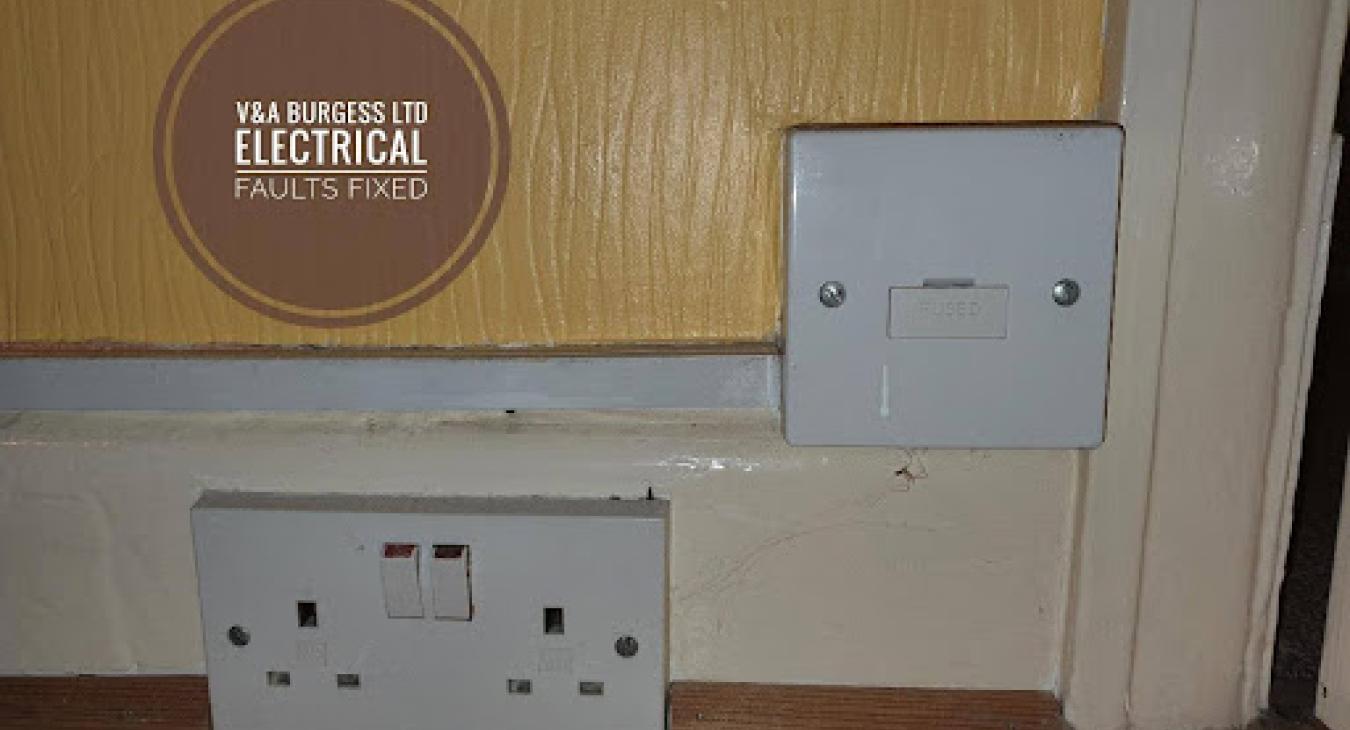
1) What is a fuse socket spur?🧐
A Fuse socket spur can be seen in the photograph above. It is the small white electrical accessory that sits above and to the right of the plug socket. At the rear of the fuse socket spur there are electrical terminals that secure the cabling tightly and to direct power to the require location. Internally the fused spur has a small chamber that contains a fuse. The size of the fuse is chosen by careful consideration of the required demand or by the manufacturer’s specifications of any appliance or equipment that is to be connected.
Back to top2) What does a fuse socket spur do?
The fuse socket spur is used in electrical installations where there is a need to separately lower the available electrical current supplied to cables, appliances, and other parts of the wiring system. Some appliances and fittings come with recommendations or requirements from the manufacturer that mean the available electrical current has to be lowered in order to safely install and power their equipment. This is sometimes known as ‘fusing down the supply’, limiting the electrical current available.
Such equipment that might require ‘fusing down’ could be:
- An outdoor floodlight
- A Gas Boiler
- Wall heaters that are permanently connected
- Bathroom or kitchen fans
- Plinth heaters
- Kitchen hob extractors
- A portion of a circuit supplying several sockets in a conservatory for example
Every appliance we purchase is effectively ‘fused down’ by its plug top and the fuse contained within it. The FUSE SOCKET SPUR performs a similar task.
Back to top3) What types of fuse socket spur are there?🔎
There are different types of fuse socket spur available for electricians to select and install. The different types are:
Unswitched fused spur – This type is often installed before an alarm system or other equipment that should not be accidentally turned off, camera systems, fire alarm systems and so on. The switch is not necessary or even desirable as the equipment should need to operate almost continually.
Switched fused spur – This is the more common type and is often installed at a Gas Boiler, before an outdoor socket, to provide power to a conservatory or to control the supply to kitchen appliances that are difficult to move such as washing machines, dishwashers, or fridge freezers. These types of appliance may need to be shut off in order to make then safe in the event of problems and accidentally turning them off won’t lead to electrical danger or security risk.
Fused spur with flex outlet – This type of device is just like the switched fused spur but has the ability for a flexible cable to exit from the faceplate to go to an appliance such as a towel radiator, boiler, or something else. The electrician usually wires the power supply to the device and the gas engineer will add the flex in when the boiler is installed.
RCD fused spur – This type of fused spur offers electric shock protection to anything that it is feeding and is often the preferred device when adding on to old electrical systems that do not comply with modern electrical wiring safety regulations. They are not suitable for all types of new electrical installation works and your electrician is best placed to decide on their suitability and use for your home and requirements.
Back to top4) What should NOT be installed using a Fuse Spur?
There are certain types of equipment that should not be installed on a fused spur. Generally, this would be high powered appliances requiring over 10 amps of electrical current on a continuous basis such as Electrical boilers, Immersion elements for water tanks or high-powered wall heaters requiring over 10 amps. In cases such as these, the likelihood is that within a short space of time the FUSED SOCKET SPUR will likely overheat, melt, catch fire or trip the electrical supply (hopefully this one first).
Back to top5) Can a fused spur be used outside?🌳
There are fused spurs that are able to be safely installed outside and subject to the elements. Manufacturer’s instructions should be adhered to along with the relevant sections of BS7671: Requirements for Electrical Installations. Outside fused spur devices should be suitably rated for the weather and elements to which they will be exposed. Typical uses outside could be a small supply to a shed, garden lighting or pond equipment.
These devices should never be used to ‘limit’ the supply of current deliberately as they are likely to continually blow or at worst, catch fire.
6) Where is best to purchase?
Careful consideration should be given to the purchase of electrical equipment. We would always recommend using a well-known or trusted wholesaler of electrical equipment, well known stores, or physical shop locations that faulty products can be returned to. Extreme caution should be exercised when purchasing electrical accessories from online auction sites, sites situated outside of the country you are in or other places. Each country will have their own required standards to which electrical equipment and accessories should be fabricated to, you should check the required markings on equipment in the country you are in. Fake, poorly manufactured or questionable quality electrical accessories can lead to overload, fire, or electric shock and as such make sure the source from which you are purchasing is reputable and safe. A FUSED SOCKET SPUR has an important job to do and high electrical demands are often placed on this type of electrical device. As such, it is vital that these are manufactured and designed according to the standards in each country in which they are used.
📞 01925 595 980 (Warrington)
📞 0151 351 4011 (Liverpool)
📧 Enquire online
💻 Visit our website
Back to top









